Children of parents who use opioids have twice the suicide rate of other children, according to researchers from the Universities of Chicago and Pittsburgh.
Nearly 700 children whose parents had filled opioid prescriptions in the last year attempted suicide while only 212 children whose parents had not used opioids tried to commit suicide, out of the 330,000 total children in the study, published in Psychiatry, an American Medical Association journal.
These findings demonstrate that, independent of age, sex, location, or parental history of suicide attempts, parental opioid use doubles the risk for suicide attempts by their children.
The rate of opioid use and abuse in the United States has continued to rise over the past 15 years, along with the youth suicide rate. The study, using health insurance claims data, analyzed whether there was an increased risk of suicide attempts for children aged 10 to 15 whose parents aged 30 to 50 filled opioid prescriptions for more than a year between 2010 and 2016.
This highlights the need for improved surveillance, recognition, and treatment of opioid use disorder among adults.
The study did not look at children of parents who use illegal opioid drugs without a prescription.
Suicide was the second leading cause of death for children 10 to 19 years old after accidental deaths, according to the CDC. Mental health screening and care for the children of parents with opioid use disorder “could help reverse the upward trend in deaths due to the twin epidemics of suicide and opioid overdose,” said Robert D. Gibbons, who directs the Center for Health Statistics at UChicago.
The researchers note that “surveys of opioid misuse find that the rates of opioid misuse in the past year among those with medical assistance, Children’s Health Insurance Program or with no insurance are more than double the rates among those who have private insurance.” This recognizes the importance of incorporating the costs of assessment and clinical needs of the children when estimating the treatment needs of families affected by opioid abuse.

